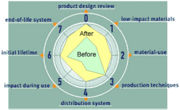Design for environment
From DDL Wiki
(→Strategies for DFE) |
(→Strategies for DFE) |
||
| Line 113: | Line 113: | ||
*Safer Incineration | *Safer Incineration | ||
*Design for Disassembly | *Design for Disassembly | ||
| + | *Use Recyclable Materials ''for which a market exists'' | ||
| + | *Prefer Recycling to "Down Cycling" | ||
| + | *Integrate Functions into Fewer Parts | ||
| + | *Avoid Large Variety of Materials | ||
| + | *Avoid Elements that Interfere With Recycling (stickers on plastics) | ||
| + | *Mark Part Material | ||
Revision as of 23:25, 4 February 2007
Design for Environment refers to procedures and processes for analyzing the environmental impact of a product throughout its life cycle and making design changes to reduce impact. Full accounting of the environmental impact of a product throughout its life is called life cycle assessment. DFE is one approach that designers can take toward sustainable development.
Environmental Issues
Major environmental issues affected by design choices include:
- Climate change
- Green house gasses (CO2, etc)
- Air pollution
- Ozone depletion
- Water polution
- Toxics (metals and VOCs
- Oxygen demand, (eutrophication)
- Nutrients, salts, thermal
- Microbial hazards
- Water depletion
- Solid waste
- Landfill resources and containment
- Spills and illegal dumping
- Hazardous waste
- Resource depletion
- Biodiversity
- Distribution of wealth
Strategies for DFE
While a full, detailed study may be necessary in many cases in order to assess environmental aspects of a product to determine which design changes will make significant reductions in environmental impact, some heuristics and rules of thumb can be successful in improving products. In practice, improving a design with respect to environmental metrics involves:
The LIDS wheel is one example of a framework for thinking about strategies to reduce environmental impact.
The LIDS wheel is based in part on the United Nations Environmental Program’s PROMISE Manual and adapted by the National Research Council of Canada. It provides a basic framework that you can use systematically to review the entire life cycle of a product. It is a tool that can:
- Stimulate the creative design process.
- Assist in visualizing current environmental performance.
- Highlight opportunities for improvement.
Optimizing your product’s performance will require a balance of functional, economic and environmental elements. The wheel begins with new product concepts, and covers design, materials selection, production, distribution, and the use and end of a product’s life. Although the strategies are numbered consecutively based on a product’s life cycle, you will find the sequence for implementing the strategies is not the same for every product. In other words, there is no one way to use of the strategies that is “right”; the sequencing depends on the needs of your organization and the product’s production.
0. New Concept Development
- De-materialization (email, voice mail)
- Increase Shared Use (carpooling)
- Integration of Functions (telephone/fax/scanner/printer, laptops)
- Functional optimization (alternative powertrain systems)
1. Select Low Impact Materials
- Avoid Toxics (Pb, Hg, etc)
- Avoid Ozone Depleters (CFCs)
- Avoid Hydrocarbons
- Leaner Materials
- Renewable Materials
- Low Energy Content Materials
- Recycled Materials
- Recyclable Materials
2. Reduce Material Amount
- Reduce Weight (rigidity by design, avoid oversizing)
- Reduce Transport Volume (smaller size, less packaging, nestable)
3. Eco-Manufacturing
- Chose Alternate Production Processes
- Low emission production (bend instead of weld, join instead of solder)
- Use materials efficiently (power coat vs. spray)
- Eliminate Production Steps
- Net shape casting vs. machining
- Integrated surfaces to avoid painting
- Reduce Energy Consumption
- Use Renewable Energy
- Reduce Production Waste
- Fewer/Cleaner Production Consumables
4. Optimize Distribution
- Less/Cleaner/Reusable Packaging
- Energy Efficient Transport Mode
- Energy Efficient Logistics
5. Reduce Use-Phase Impact
- Lower Energy Consumption
- default power down
- programmable clocks
- reduce mass of movable products
- insulation
- Cleaner Energy Sources
- wind, solar, renewables
- Low sulfur coal
- Rechargeable batteries
- Reduce Consumables
- Batteries, fluids, coffee filters, etc
- Minimize leaks
- Reusable consumables
- Cleaner Consumables
- Reduce Consumable Waste
6. Maximize The First Life
- Increase Reliability and Durability (FMEA)
- Easy Maintenance and Repair
- Indicate procedure for disassembly, cleaning, maintenance
- Indicate subassemblies that wear and locate for easy access
- Design for Modularity (upgrades and style changes)
- Avoid Trendy Designs
- Promote Product-User Relationships
7. End of Life
- Reuse of Product (sylistic and technological obsolescence)
- Re-manufacturing / Re-furbishment of Product
- Recycling of Materials
- Safer Incineration
- Design for Disassembly
- Use Recyclable Materials for which a market exists
- Prefer Recycling to "Down Cycling"
- Integrate Functions into Fewer Parts
- Avoid Large Variety of Materials
- Avoid Elements that Interfere With Recycling (stickers on plastics)
- Mark Part Material

